Fluid Kinematics - Kinematics is the branch of classical mechanics that describes the motion of bodies and systems without consideration of the forces the cause the motion.
Types of Fluid Flows
Fluid flow may be classified under the following headings;
Steady & Unsteady Flow
Steady Flow
At a fixed position, if fluid properties and flow parameters do not change with time then it is a steady flow.

Unsteady flow
If fluid properties and flow parameters changes with time as a fixed position then it is called unsteady flow.
For the Unsteady flow:

Uniform & Non-uniform Flow
The flow is defined as uniform flow when in the flow field the velocity and other hydrodynamic parameters do not change from point to point at any instant of time.
For Uniform Flow

While a flow in which the velocity and other hydrodynamic parameters changes from one point to another the flow is defined as non-uniform.
For Non uniform flow
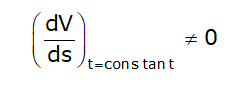
Laminar & Turbulent Flow
Laminar flow is type of flow in which the fluid particles move along well-defined paths or steam line & all the streamlines are straight & parallel. Thus, the particles move in layers gliding smoothly over the adjacent layer.
Whereas in Turbulent flow, the fluid particles move in a zig zag way which results in eddies formation which are responsible for the energy loss.
Compressible flow & Incompressible flow
Compressible flow is a type of flow in which density of the fluid changes from point to point.
ρ ≠ constant (For compressible flows)
Whereas a flow in which the density is constant for fluid flow is called the incompressible flow.
ρ = constant (For incompressible flows)
Rotational & Irrotational Flow
Rotational flow is the type of flow in which the fluid particles while flowing along streamlines also rotate about their own axis whereas a flow in which the fluid particles while flowing along the streamlines do not rotate about their own axis.
One-dimensional (1- D), Two-dimensional (2-D) and Three-dimensional (3-D)
flows:
1-D is a type of flow in which flow parameter such as velocity is a function of time & one space co – ordinate only.
2- D is a type of flow in which flow parameter such as velocity is a function of time & two space co – ordinate only.
3 -D is a type of flow in which flow parameter such as velocity is a function of time & three space coordinate only.
Combining these, the most common flow types are:
- Steady uniform flow
- Conditions do not change with position in the stream or with time.
- E.g. flow of water in a pipe of constant diameter at a constant velocity.
- Steady non-uniform flow
- Conditions change from point to point in the stream but do not change with time.
- E.g. Flow in a tapering pipe with constant velocity at the inlet.
- Unsteady uniform flow
- At a given instant in time the conditions at every point are the same but will change with time.
- E.g. A pipe of constant diameter connected to a pump pumping at a constant rate which is then switched off.
- Unsteady non-uniform flow
- Every condition of the flow may change from point to point and with time at every point.
- E.g. Waves in a channel
Flow Pattern
Three types of fluid element trajectories are defined: Stream lines, Path lines, and Streak lines.
Stream lines
A streamline at any instant can be defined as an imaginary curve or line in the flow field so that the tangent to the curve at any point represents the direction of the instantaneous velocity at that point.
Only for steady flow, streamlines remain same at all instants of time.
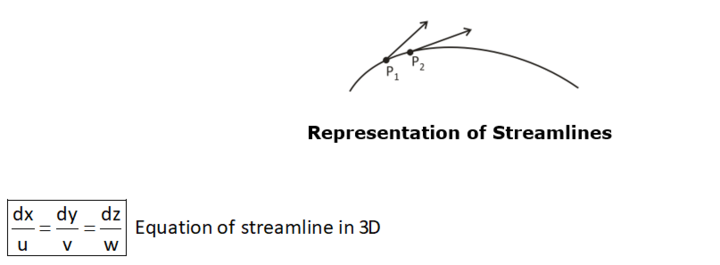
Path lines - A path line is the actual path travelled by an individual fluid particle over some time period.
An example of a path line is the trajectory taken by one puff of smoke which is carried by the steady or unsteady wind.
Streak-line:
A streak line is the locus of fluid particles that have passed sequentially through a prescribed point in the flow.
An example of a streak line is the continuous line formed by the smoke emitted by a chimney at point P.
Timeline:
A timeline is a set of adjacent fluid particles that were marked at the same (earlier) instant in time.
- In a steady flow, streamlines, pathlines, and streaklines all coincide.
Velocity of Fluid Particle
- Velocity of a fluid along any direction can be defined as the rate of change of displacement of the fluid along that direction
- Let V be the resultant velocity of a fluid along any direction and u, v and w be the velocity components in x, y and z directions respectively.
- Mathematically the velocity components can be written as
u = f ( x, y, z, t )
v = f ( x, y, z, t )
w = f ( x, y, z, t )
- Let V is resultant velocity at any point in a fluid flow.
- Resultant velocity

- Where u,v,w are the velocity vectors in X, Y and Z directions, respectively.
CONTINUITY EQUATION
This equation is based on the principle of conservation of mass.
Consider two cross sections of a pipe as shown in Figure.
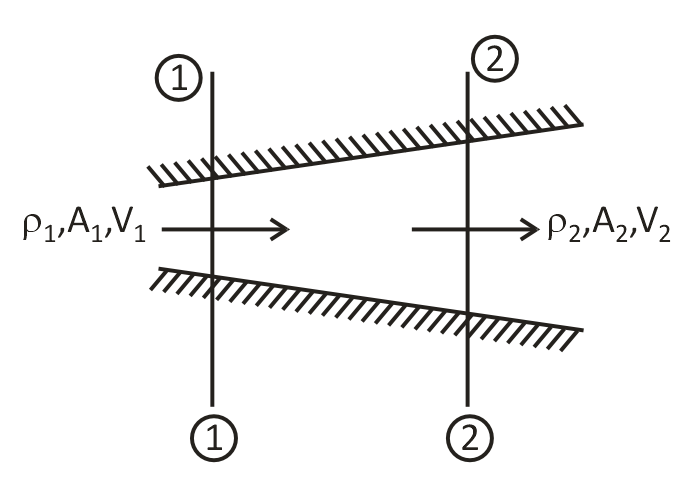
By continuity equation:
Mass flow rate at inlet = mass flow rate at outlet
ρ1A1V1 = ρ2A2V2 (If fluid in compressible).
A1V1 = A2V2 (if fluid is Incompressible i.e. ρ = constant).
Continuity Equation for Steady and 3 – D Incompressible Flow:

Continuity Equation for Steady and 2 – D Incompressible Flow:

Acceleration of Fluid Particle
- Acceleration of a fluid element along any direction can be defined as the rate of change of velocity of the fluid along that direction.
- If ax , ay and az are the components of acceleration along x, y and z directions respectively, they can be mathematically written as

Where ax, ay, az are the acceleration vectors in X, Y and Z directions, respectively.
Angular velocity
Angular velocity of a fluid particle is given as:
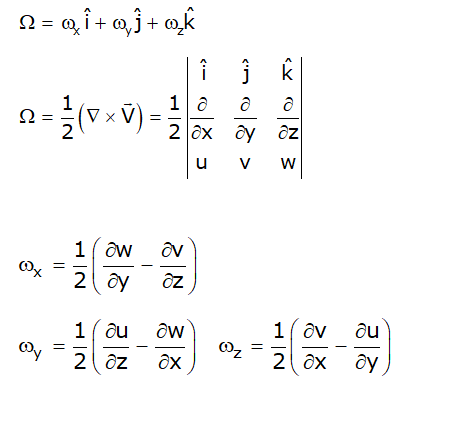
Note- For an irrotational motion of a fluid particle, angular velocity is zero. i.e. ω=0
VORTICITY (ζ)
Vorticity (ζ) in the simplest form is defined as a vector which is equal to two times the rotation vector. It is given by:

Vorticity is equal to curl of velocity vector.
NOTE - If vorticity at a point in fluid flow is zero, then flow in that region is called irrotational flow.
VELOCITY POTENTIAL FUNCTION
- It is a scalar function of space & time such that its negative derivate with respect to any direction gives the fluid velocity in that direction. It is denoted by ϕ.
Hence, 
- The velocity potential function (ϕ) exists, the flow should be irrotational e. when ∇×V =0
- If velocity potential function satisfies the Laplace equation, it represents the possible steady incompressible irrotational flow.
- Steady incompressible flow, the continuity equation is given by:
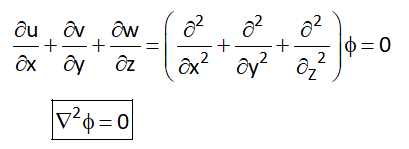
NOTE If velocity potential function satisfies Laplace equation, flow will exist.
NOTE if velocity potential function exists the flow will be irrotational.
- STREAM FUNCTION
It is defined as the scalar function of space and time, such that its partial derivative with respect to any direction gives the velocity component at right angles to that direction.
It is denoted by the ψ and defined only for the two – dimensional flows.
Mathematically, for the steady flow it is defined as ψ = f(x,y) such that:

Equation of Streamline:
Along the stream lines dΨ = 0
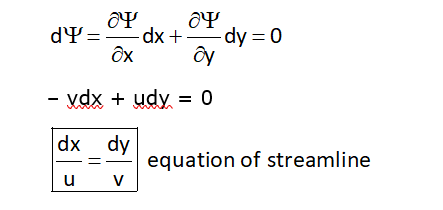
Note.
Stream function exists both for rotational as well as irrotational flows Whereas velocity potential function exists only for the irrotational flow.
Equation of equipotential line:
A line along which the velocity potential Φ is constant, is called equipotential line.
For equipotential line, Φ = Constant
dΦ= 0
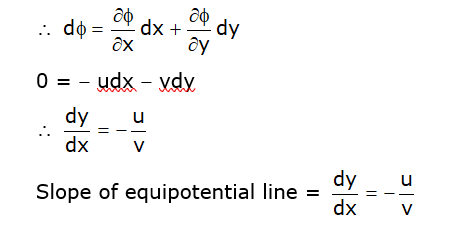
Relation between equipotential line and streamline
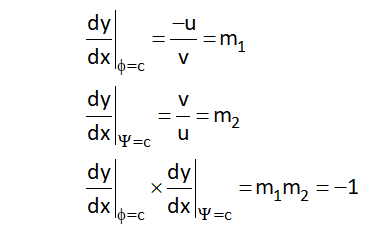
Hence, equipotential lines and streamlines are ORTHOGONAL to each other everywhere in flow field except at stagnation point where
No comments:
Post a Comment
Knowing brings controversy